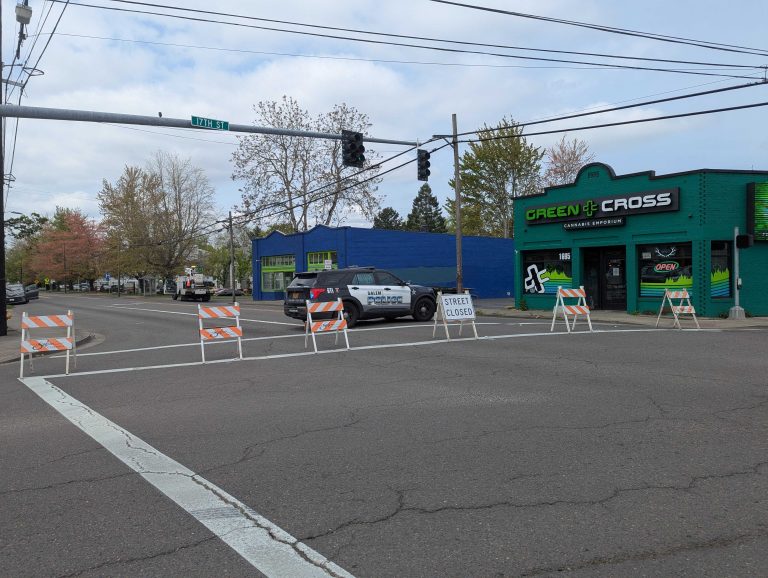UPDATE: Council approves compromise motion on SCAN overlay zones

In a two hour meeting mostly made up of public testimony, the Salem City council on Monday approved a motion to modify and remove overlay zones in the South Central Association of Neighbors, and an in-kind grant to treat an invasive plant at the Oxbow Slough.
The meeting began with City Manager Keith Stahley’s announcement that the city would withdraw its appeal to the Oregon Supreme Court challenging an appellate judge’s finding that former firefighter Mo Stadeli’s 2019 death from tonsillar cancer was related to his work. Read more on that decision here.
Following the announcement, over a dozen current and former firefighters, some of whom are cancer survivors, spouses and union members testified to the city about the importance of protecting benefits for the families of firefighters, and the impact of Stadeli’s work for Salem.
Eliminating overlay zones in the SCAN neighborhood – compromise motion approved
Councilors revisited an ordinance to eliminate five special districts, called overlay zones, to allow for taller buildings, denser housing and mixed-use development in the South Central Association of Neighbors. They ultimately approved a compromise motion to retain two zones with a height limit of 45 feet.
If eliminated, the new zoning would have allowed for buildings 55, 65 and 70 feet tall, which would encourage denser, mixed-use housing, according to a June staff report.
During Monday’s meeting, several residents of the neighborhood spoke in favor of limiting building heights to preserve the look of the neighborhood, and limit the impact of extensive development on street parking and pedestrian safety.
Councilor Linda Nishioka proposed a substitute motion to eliminate the Oxford-West Nob Hill zone, the Oxford-Hoyt zone and Hoyt-McGilchrist zone immediately, and to increase the maximum height of zone 1, Saginaw Street, and zone 2, Superior-Rural to 45 feet, and remove all other development standards in those two zones.
Though the overlay zone would be eliminated in Oxford-Hoyt, buildings would still be limited to 35 feet there due to the existing city zoning and neighboring buildings, she said.
Forty-five feet would accommodate three story developments, potentially four depending on ceiling height, Nishioka said.
“I have been working very hard at trying to find a compromise that helps facilitate the SCAN neighborhood, Fairmont and all these overlay zones as well as recognizing that development does need to happen through the transit corridor. But limiting that height to 45 feet, because that probably will allow a developer to be able to make the bottom line,” she said.
Councilors said they felt the compromise was well thought-out, and balanced the wants of the neighborhoods with advancing the city’s goal of developing denser, more climate friendly housing.
The council passed Nishioka’s motion unanimously.
Clearing an invasive plant from the Oxbow Slough – approved
The city council unanimously approved a letter of support to the Willamette Riverkeeper for a grant to clear the invasive ludwigia plant from the Oxbow Slough, located in Riverfront Park. The plant blocks sunlight and chokes up clear waterways harming local wildlife.
The approval included an estimated $70,000 of in-kind support from the city in the form of advice, environmental monitoring, logistics assistance, disposal and public outreach during the five-year project, according to a report from Brian Martin, public works director.
The group has spent the last several years removing the plant from the Willamette Slough, in a nearly completed project expected to be successful.
Original Story:
Invasive plant removal and mixed-use housing development are on the agenda for the Salem City Council’s meeting on Monday, Sept. 25.
READ IT: AGENDA
Monday’s meeting starts at 6 p.m., and will be in-person at the city council chambers, 555 Liberty St. S.E., room 220, with the meeting also available to watch online. The meeting will be livestreamed on Capital Community Media’s YouTube channel, with translation to Spanish and American Sign Language available. Anyone may attend the meeting to listen or comment.
The public comment portion of the meeting takes place after opening exercises, such as roll call and the Pledge of Allegiance, and residents are invited to comment on any topic, whether it appears on the agenda or not. If a public comment does not relate to an agenda item, it may be saved for the end of the meeting.
To comment remotely, sign up on the city website between 8 a.m. and 2 p.m. on Monday.
For written comments, email [email protected] before 5 p.m. on Monday, or on paper to the city recorder’s office at the Civic Center, 555 Liberty St. S.E., Room 225. Include a statement indicating the comment is for the public record.
Clearing an invasive plant from the Oxbow Slough
After several years of work to clear the invasive ludwigia plant from the Willamette Slough at Minto-Brown Island Park, the group Willamette Riverkeeper hopes to address the issue at the Oxbow Slough.
The group seeks a letter of support from the city council to apply for a $280,000 grant from the Oregon Watershed Enhancement Board for the next project. It would require $70,000 of in-kind support from the city in the form of advice, environmental monitoring, logistics assistance, disposal and public outreach during the five-year project, according to a report from Brian Martin, public works director.
The Oxbow Slough is located within Minto-Brown Island Park, and has 55 acres of water surface area. The ludwigia plant, which blocks sunlight and chokes up clear waterways harming local wildlife, is estimated to take up 75% of the total area.
The funding decision would be made in April, with the project starting as early as May. Treatment over the five year period includes herbicide treatment and hand-pulling of the plants.
Read more about the nearly completed Willamette Slough project below:
Eliminating overlay zones in the SCAN neighborhood
Councilors will revisit an ordinance to eliminate five special districts, called overlay zones, to allow for taller buildings, denser housing and mixed-use development in the South Central Association of Neighbors.
The council rejected a similar ordinance in a 4-5 vote in June, after hearing nearly two hours of information and public testimony, most opposed to the change saying it would disrupt the historic appeal of the neighborhood. In July, they adopted a motion to reconsider the topic, and delayed deliberation until Sept. 25.
If eliminated, the new zoning would have allowed for buildings 55, 65 and 70 feet tall, which would encourage denser, mixed-use housing, according to a June staff report. Sixty-five feet is around five stories tall.
A September staff report from Kristin Retherford, community and urban development director, answers questions about the National Register Residential Historic District, which could impact height limitations for a limited set of buildings. The report also said the city council could opt to eliminate some zones, but not all five.
Monday’s vote will consider advancing the ordinance to a second reading and later vote.
Info on study of walkable, mixed use areas
The council will hear the results of a study which identified three potential areas to develop walkable, mixed-use infrastructure: downtown, north downtown and inner west Salem.
READ IT: Walkable, mixed-use areas study
The study was required by new state rules to promote climate-friendly and equitable infrastructure, and conducted through a city collaboration with the Mid-Willamette Valley Council of Governments. The state requires that the city take steps to promote development in the identified areas, improving walkability and access to businesses and housing.
The three areas were previously highlighted by community feedback for such developments in the recently-completed Our Salem project. The recent study evaluated the zoning and capacity of the areas, and the transportation, utilities and parks in and near them.
The study also includes a community engagement plan, and evaluated ways to limit displacement due to gentrification, which will be incorporated into the city’s Housing Production Strategy planned for the end of 2025, according to a staff report from Retherford.
Other agenda items
-Councilors will see the monthly purchasing report which shows the awards made from the city for contracts in August.
-The council will see a planning administration decision that approved an application to divide a 20.5 acre property on 5791 Skyline Rd. S. into three parcels.
-The council will see a hearing officer decision which approved a child day care center at the Westminster Presbyterian Church on 3737 Liberty Rd. S.
Budget discussions
The city council met Monday, Sept. 18, to begin its discussion on potential cuts if the payroll tax fails in the November election. Read details about the meeting below:
Contact reporter Abbey McDonald: [email protected] or 503-704-0355.
SUPPORT OUR WORK – We depend on subscribers for resources to report on Salem with care and depth, fairness and accuracy. Subscribe today to get our daily newsletters and more. Click I want to subscribe!

Abbey McDonald joined the Salem Reporter in 2022. She previously worked as the business reporter at The Astorian, where she covered labor issues, health care and social services. A University of Oregon grad, she has also reported for the Malheur Enterprise, The News-Review and Willamette Week.



